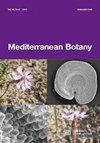Evaluating the post-fire natural regeneration of Mediterranean-type scrublands in Central Spain
IF 0.7
4区 生物学
Q3 PLANT SCIENCES
引用次数: 4
Abstract
We performed a five-year assessment of the natural vegetation restoration capacity following the 2012 fires in Valdemaqueda (Madrid, Spain) via the characterization of the post-fire and residual vegetation and the analysis of soil physico-chemical characteristics. Six pilot-plots were established in the affected site. Forest species, representative of the potential natural vegetation of the area (Juniperus oxycedrus subsp. lagunae and Quercus rotundifolia woodlands) and broom shrubs (Cytisus scoparius, Retama sphaerocarpa) were planted to assess the relationship among the stages of ecological succession, competition, and soil restoration processes following devastating fire events. The fire-driven alteration of the soil’s physico-chemical properties was evident, given the increased pH and reduced C/N ratio in the first years of the study. However, we observed an increased soil enrichment in the last years of study, accompanied by the propagation of herbaceous species, su[1]pporting our seed bank findings, showing a clear difference in the sprouting rate between burnt and control plots (80% vs. 20%, respectively). The establishment of robust, pyrophyte shrub species (Cistus ladanifer, C. laurifolius, Rosmarinus officinalis) rather than natural succession evidenced the clear conversion of the vegetation in burnt areas. These findings in the pilot-plots allowed evidencing the high vulnerability of the natural vegetation to the settling of pyrophytes, given their low survival rate under the strong competitive pressure of these pyrophytic species. The proliferation of these pyrophytes could translate into changes in soil macro- and microbiota, nutrient dynamics, species diversity, and interaction, added to the alteration of fire regimes in the area. Overall, these results highlight the risk for soil impoverishment and possible erosion of the fire-affected sites. Moreover, they underline the importance of the establishment and regeneration of Genisteae species to outcompete pioneer pyrophytic species, favoring the restoration of the area’s potential natural vegetation评估西班牙中部地中海型灌木丛火灾后的自然再生
我们对2012年西班牙马德里瓦尔德马奎达火灾后的植被恢复能力进行了为期五年的评估,方法是对火灾后和剩余植被的特征进行描述,并对土壤理化特征进行分析。在受影响的地点建立了六个试验田。代表该区潜在天然植被的森林树种(Juniperus oxycedrus subsp.)。研究了森林火灾发生后不同阶段的生态演替、竞争和土壤恢复过程之间的关系。在研究的头几年,土壤的pH值升高,碳氮比降低,因此,火灾对土壤理化性质的影响是明显的。然而,在过去几年的研究中,我们观察到土壤的富集程度增加,伴随着草本物种的繁殖,这与我们的种子库发现相一致,显示出燃烧和对照地块之间发芽率的明显差异(分别为80%和20%)。粗壮的腐植灌木物种(山竹、月桂、迷迭香)的建立,而不是自然演替,证明了燃烧区植被的明显转变。这些在试验区的发现证明了天然植被对焦植物的高度脆弱性,因为在这些焦植物物种的强大竞争压力下,它们的存活率很低。这些植物的增殖可以转化为土壤宏观和微生物群、养分动态、物种多样性和相互作用的变化,并增加了该地区火灾制度的改变。总的来说,这些结果突出了受火灾影响的土壤贫瘠和可能的侵蚀的风险。此外,他们强调了金雀花科物种的建立和更新的重要性,以胜过先驱的热生植物物种,有利于恢复该地区潜在的自然植被
本文章由计算机程序翻译,如有差异,请以英文原文为准。
求助全文
约1分钟内获得全文
求助全文
来源期刊

Mediterranean Botany
Agricultural and Biological Sciences-Plant Science
CiteScore
2.40
自引率
10.00%
发文量
30
审稿时长
12 weeks
期刊介绍:
Mediterranean Botany (ISSNe 2603-9109), formerly Lazaroa, is a biannual journal that publishes original research studies in the field of Botany including plant systematics, vegetation ecology, biogeography, evolutionary biology, ecophysiology, community ecology, ethnobotany and conservation biology on Mediterranean biomes but also in interacting areas.
Mediterranean Botany is an OPEN ACCESS Journal, free of charges for any published article.
 求助内容:
求助内容: 应助结果提醒方式:
应助结果提醒方式:


